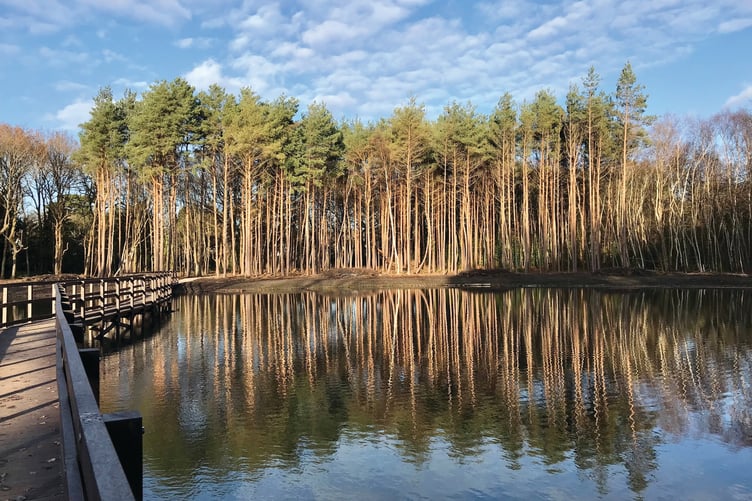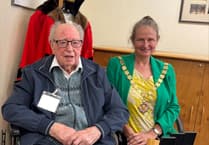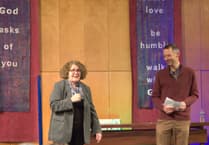Please send your items of community gossip to [email protected]
Know who you are?
When I settle down to write my next community page, the first thing I do is copy down information from the previous issue – the fact that this is now the 483rd such page I have written, and the date on which it will be published.
It is always slightly disconcerting for me when the next issue will be published in the next month – it really proves how time races. Here I am in April and the next issue is for May 2 – that has a familiar ring to it. Oh, yes, election day. And yes, I have made sure my driving licence is in my wallet, as proof of who I am.
Woking Borough Council and others, such as television and national papers, have been reminding us all for ages that we shall not be permitted to vote unless we have proof of identity with us. Yet there will be those who turn up at the polling station, on the right day, but without that proof.
And do read that poll card which has been delivered to you: just in case the polling station which you have been attending for the last I don't know how many elections has now been changed. Many schools were once used as polling stations but it was considered not a good thing to keep the pupils from their books.
I said read that poll card – just in case you forget it is headed: “You Must Bring Photographic Identification to Vote”.
A friend has just received a new passport. Like many of us she despairs of the photographic likeness, swearing it is nowhere near her. I wonder if she has an old portrait in the attic? But would she be recognised from it?
Ever since my daughters and I took part in Changing Places, the Woking Community Play performed back in 1992, I have asked to make sure they all vote: the play largely revolved around the Suffragette movement in Woking and the lengths to which women went to gain the vote. I don't care what my daughters vote for, but I do care that they use their hard-earned right to vote.
All fayre?
So now the Horsell Scouts and Guides Grand May Fayre is only days away – May 6.
As always there are so many last-minute things to do – and worry about. This year there were more worries than usual with WBC cuts in funding for many things we take for granted.
Would the grass be cut? Would the toilets be open? Who would supply sacks for rubbish? Who would take the rubbish away?
Many problems could, in the “old” days be settled by keen volunteers. But these days there is a fearsome monster called Healthnsafety who stands in the way of so many commonsense ideas which would solve so many problems.
Do go along to the Wheatsheaf Green on Monday afternoon and see whether the brave knight Wecandoit successfully felled all who stood in the way.
You may possibly see a routed monster. You will certainly have fun.
Of gherkins and Jenga
The picture on this page last week, of the tower block in Amsterdam, is not my favourite of the towers in that area. It is not bland, which is certainly in its favour, even if it does, as has been suggested, look like a half-played game of Jenga.
The Stirling Prize for Architecture is an annual award presented by the Royal Institute of British Architects – RIBA – which has celebrated the very best contemporary buildings since 1996.
Some of the winners, such as Norman Foster's Gherkin of 2004, have become enormously successful and appreciated by the wider public. Others have proved harder to love.
A lecture, British Architects Oscars, will be given by Brian Stater to The Arts Society Mayford – TASM – on May 9 and will look at some of the hits, some of the misses, and several buildings that, arguably, should have won but didn't.
Brian lectured at University College London for 25 years, retiring in 2021 as a senior teaching fellow. His principal academic interest lay in the appreciation of architecture and he has a lifelong enthusiasm for photography. This entertaining talk will take place on Thursday, May 9 at 10.30 am at Welcome Church, 1-5 Church Street West, Woking, GU21 6DJ.
Lectures are free for TASM members, but cost £10 for non-members. Anyone wishing to visit should contact Richard Brace on 01932 344305 or [email protected]
Want a dewy complexion?
Along with his recent memories of the Sheep Wash on Horsell Common reader Nigel Searle recalled all the boggy places around where the Rive Ponds now sit. He, and I, remember the sphagnum moss and the fascinating sundew.
As a child I would try to feed the carnivorous sundew with tiny flies. Because this strange plant grows on poor heathland soils it needs to add something to its diet, and a few small insects fit very well, giving it the nutrients the soil lacks.
If you don't know this tiny plant it has sticky droplets covering its leaves to trap its next meal. I have not noticed any in the Rive Pond area but I do remember it in the lower reaches of the Danewell Gutter on Horsell Common, which runs from a pond to the south side of the main track down the slope towards and, eventually to, the Bourne.
There used to be a lot of bog cotton growing there as well but it has been some time since I walked that area and must obviously, for pleasure as well as for research on the part of my readers, take the walk once more.
Nigel will, therefore, be pleased to learn that Horsell Common Preservation Society (HCPS), has been doing some work on the gutter: “Its existing pools of standing water and damp environment must be maintained”. To this end, HCPS is looking to start a system of leaky dams to keep the water table high.
The “dew” of the sundew is said to have been favoured by medieval alchemists and herbalists because of their claim that it “would burn off warts and excite lust in cattle”.
Dew is rather magical stuff in that it makes the grass wet even in the absence of rain. Perhaps this is why the tradition of washing in dew started. Possibly as a pagan idea for it was associated with May Day – sorry, you’ve missed that First of May dew bathe this year.
It was likely connected with the Druid festival of Beltane, which was usually marked on about May 1 as the start of summer. There would be ritual fires in honour of the sun, and to ensure an abundance of corn and an increase in their cattle. Would sundew's ability to “excite lust in cattle” encourage the increase?
You had to be up early to bathe your face in the dawn dew. If it was good for plants, surely it would be good for the face, resulting in a genuine dewy complexion.
If word gets out concerning the possible medical claims for the dew of sundew I suspect there will be many walkers with their eyes, and wellies, firmly planted on the boggy land of Horsell Common.
More common thoughts
Perhaps it was my comments on how the tracks on Horsell Common which I knew as a child have altered, and some have been lost, which got Nigel Searle thinking about his young days roaming the common. Thanks to Bill Pugh we have discovered the history of the Sheep Wash. Tick! (I'll tell you next week – I've run out of space!)
Nigel also mentioned the boggy parts of the common, particularly sundew. Tick!
More common memories surfaced and Nigel wrote: “A popular family outing used to be to the sandpits, but I have a vague recollection of visiting another, Second World War-related, site near by which has since disappeared almost completely – although some possible traces of it can be found if you know where to look.
“If my memory is correct, the site comprised a number of concrete blockhouses – rather than pillboxes – which my parents said was an ammunition depot (presumably for the anti-aircraft battery at Durnford Farm off Martyr's Lane, possibly also for that at Old Woking's Broad Mead).
“For some years, not having come across anyone else who knew of the site or ever seen any photos of it, I wondered if my childhood memories (I would only have been five or six at the time) might have been playing tricks with the blockhouses being somewhere else altogether."
Personally, I remember the dilapidated building on the slope down to the “old” sandpit which was, I believe, where someone sat counting the loads of sand taken away. I also remember some temporary homes beside the Main Track/Sandy Track/Military Road/Rotten Row(!).
I also remember the buildings at the back of Durnford Farm – where I learnt to ride a pony – which I believe were used to house Italian PoWs. I was, of course, forbidden to investigate that one. I also remember Canadian troops on the common in the Anthonys area.
But I went back to Bill Pugh to see what he knew. He mentioned another local resident of long-standing: David Evans, who as a boy visited those Canadians. Bill suggested the site of the buildings would have been near the Main Track if you were standing at Danewell Pond, and looking north it would have been on the higher ground to the left.
“This may account for the non-native scarlet oaks in that area that produce a show in the autumn. I have always assumed that someone may have planted them as a reminder of home,” wrote Bill.
If you want to know something, ask my readers – or join the Woking History Society and the Horsell Common Preservation Society.
An appealing event?
Bells. Door bells. Ring for attention bells. School's out bells. Bicycle bells – why don't all cyclists have, and use, them? Avon calling bells. Church bells.
If you have ever wondered about that last-listed sort of bells then a visit to Pirbright could tell you all you need to know – probably.
St Michael's Church is having a bell tower open day on Saturday, May 25 from 10am to midday. This will show you how those bells work, who rings them, why they sound so different from bells ringing in other parts of the world.
Would you like to have a go and try your hand at ringing? It is suggested you may like to take the Tenor Challenge – can you get it to chime? Not to worry if you drop a clanger – there will be cake, and all things improve with cake.


.jpeg?width=209&height=140&crop=209:145,smart&quality=75)

Comments
This article has no comments yet. Be the first to leave a comment.